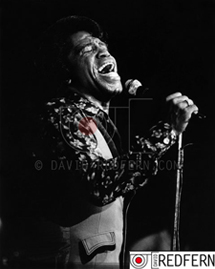 James Joseph Brown, May 3rd, 1933 – December 25th, 2006 was an American singer, songwriter, musician and recording artist. Widely regarded as the originator of funk music, Brown can be seen as a major figure of 20th century popular music and dance.
James Joseph Brown, May 3rd, 1933 – December 25th, 2006 was an American singer, songwriter, musician and recording artist. Widely regarded as the originator of funk music, Brown can be seen as a major figure of 20th century popular music and dance.
Born in South Carolina, Brown was raised in extreme poverty and a broken family home after his mother abandoned the family when Brown was aged 2. At age 6, his father sent him to live with his aunt who ran a house of prostitution. Despite living with relatives, Brown would spend long stretches of time on his own, hanging out on the streets and hustling to get by. Dancing and singing became a part of Browns numerous ways to earn cash and in his spare time he taught himself to play harmonica and picked up guitar, piano and drums from people he met along the way.
As a young adult Brown wound up in a juvenile detention center for armed robbery. It was in his third year of his sentence that he met with future R&B legend Bobby Byrd during a baseball game against Browns reform school team. Byrd saw Brown perform there and admired his singing and performing talent and helped to secure his early release. In the years that followed Brown and Byrd formed the band which would later become The Flames. Their early work would consist of gospel-inspired R&B compositions, heavily influenced by contemporary musicians such as Ray Charles and Little Richard. Little Richard’s relations were especially significant in Brown’s development as a musician and showman. Etta James recalled that Brown “used to carry around an old tattered napkin with him, because Little Richard had written the words, ‘please, please, please’ on it and James was determined to make a song out of it…”. In 1956, The Flames had their first hit with “Please, Please, Please”, selling over a million copies. However the success of this track was followed by a series of disappointing singles. In 1957 Little Richard left popular music to become a preacher, Brown stepped in to fill the rest of his tour dates and with him some of Little Richards backing band. In 1959 Brown had a number one hit with “Try Me”, becoming the first of 17 chart-topping R&B singles by Brown over the next two decades.
Brown scored on the charts in the early 1960s with recordings such as his 1962 cover of “Night Train”. But it was his self financed Live at the Apollo album that brought Brown his main success, the album stayed on the pop charts for fourteen months, peaking at #2.
Brown followed the success of Live at the Apollo with a string of singles that essentially defined the foundation of Funk music. “Papa’s Got a Brand New Bag” and “I Got You (I Feel Good)”, both from 1965, were his first Top 10 pop hits as well as major #1 R&B hits. In his concert repertoire and on record, Brown mingled his innovative rhythmic essays with Broadway show tunes and ballads, such as his hit “It’s a Man’s Man’s Man’s World” (1966).
Brown continued to refine the new funk idiom. His 1967 #1 R&B hit, “Cold Sweat”, sometimes cited as the first true funk song, was the first of his recordings to contain a drum break and the first that featured a harmony that was reduced to a single chord. Changes in Brown’s style that started with “Cold Sweat” also established the musical foundation for Brown’s later hits, such as “I Got the Feelin'” (1968) and “Mother Popcorn” (1969). By this time Brown’s vocals frequently took the form of a kind of rhythmic declamation, not quite sung but not quite spoken, that only intermittently featured traces of pitch or melody. This would become a major influence on the techniques of rapping, which would come to maturity along with hip hop music in the coming decades.
Brown’s style of funk was based on interlocking syncopated parts: funky bass lines, drum patterns, and iconic guitar riffs. The main guitar ostinatos for “Aint” it Funky” (c. late 1960s), and “Give it Up or Turn it Lose” (1969), are examples of Brown’s refinement of New Orleans funk— irresistibly danceable riffs, stripped down to their rhythmic essence.
Brown’s recordings influenced musicians across the industry during this period and those same tracks were later resurrected by countless hip-hop musicians from the 1970s onward. As a result, James Brown remains to this day the world’s most sampled recording artist, with “Funky Drummer” itself becoming the most sampled individual piece of music.
James Brown’s performances were famous for their intensity and length. His own stated goal was to “give people more than what they came for — make them tired, ’cause that’s what they came for.'” Brown is known to have demanded extreme discipline, perfection and precision from his musicians and dancers. Brown had a practice of directing, correcting and assessing fines on members of his band who broke his rules, such as wearing unshined shoes, dancing out of sync or showing up late on stage. During some of his concert performances, Brown danced in front of his band with his back to the audience as he slid across the floor, flashing hand signals and splaying his pulsating fingers to the beat of the music. Although audiences thought Brown’s dance routine was part of his act, this practice was actually his way of pointing to the offending member of his troupe who played or sang the wrong note or committed some other infraction. Brown used his splayed fingers and hand signals to alert the offending person of the fine that person must pay to him for breaking his rules.
On December 23rd, 2006, James brown became ill and checked into Hospital the following day for observation and treatment. On Christmas Day, Brown died from congestive heart failure resulting from complications of pneumonia.
James Brown received a variety of awards and honors throughout his lifetime and after his death. He received several prestigious music industry awards and honors. In 1983, he was inducted into the Georgia Music Hall of Fame. In addition, Brown was named as one of the first inductees into the Rock and Roll Hall of Fame. In 1992, Brown was awarded a Lifetime Achievement Award at the 34th annual Grammy Awards. On June 15, 2000, Brown was honored as an inductee for the New York Songwriters Hall of Fame. On August 6, 2002, James Brown was honored as the first BMI Urban Icon at the BMI Urban Awards. His BMI accolades include an impressive ten R&B Awards and six Pop Awards. In 2006, Brown was inducted into the UK Music Hall of Fame. In 2004, Rolling Stone magazine ranked James Brown as #7 on its list of the 100 Greatest Artists of All Time.

